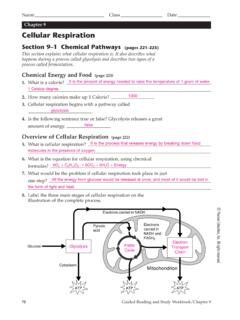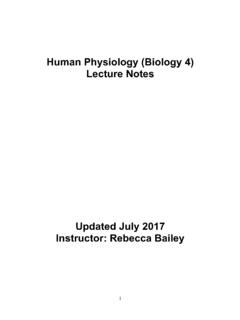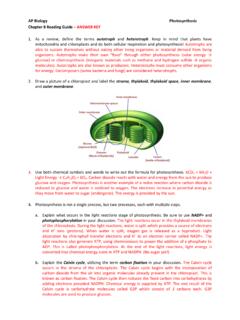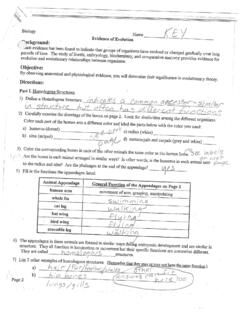Transcription of 10Organisms Respiration in
1 SCIENCE108 Respiration inOrganisms10 One day Boojho was eagerlywaiting to meet hisgrandparents who were comingto the town after a year. He was in a realhurry as he wanted to receive them at thebus-stop. He ran fast and reached thebus-stop in a few minutes. He wasbreathing rapidly. His grandmother askedhim why he was breathing so fast. Boojhotold her that he came running all the the question got stuck in his wondered why running makes aperson breathe faster. The answer toBoojho s question lies in understandingwhy we breathe. Breathing is a part ofrespiration. Let us learn about WHY DO WE RESPIRE?In Chapter 2 you learnt that allorganisms are made of smallmicroscopic units called cells. A cell isthe smallest structural and functionalunit of an organism. Each cell of anorganism performs certain functionssuch as nutrition, transport, excretionand reproduction.
2 To perform thesefunctions, the cell needs energy. Evenwhen we are eating, sleeping or readingwe require energy. But, where does thisenergy come from? Can you say whyyour parents insist that you should eatregularly? The food has stored energy,which is released during , all living organisms respireto get energy from food. Duringbreathing, we breathe in air. You knowthat air contains oxygen . We breathe outair which is rich in carbon dioxide. Theair we breathe in is transported to allparts of the body and ultimately to eachcell. In the cells, oxygen in the air helpsin the breakdown of food. The processof breakdown of food in the cell with therelease of energy is called cellularrespiration. cellular Respiration takesplace in the cells of all the cell, the food (glucose) is brokendown into carbon dioxide and water usingoxygen.
3 When breakdown of glucoseoccurs with the use of oxygen it is calledaerobic Respiration . Food can also bebroken down, without using oxygen . Thisis called anaerobic of food releases the presence of oxygenGlucose carbon dioxide + water + energyYou should know that there are someorganisms such as yeast that can survivein the absence of air. They are calledanaerobes. They get energy throughanaerobic Respiration . In the absence ofoxygen, glucose breaks down into alcoholand carbon dioxide, as given below:in the absence of oxygenGlucose alcohol + carbon dioxide + energy2021 22 Respiration IN ORGANISMS109 Our muscle cells can also respireanaerobically, but only for a short time,when there is a temporary deficiency ofoxygen. During heavy exercise, fastrunning (Fig. ), cycling, walking formany hours or heavy weight lifting, thedemand for energy is high.
4 But thesupply of oxygen to produce the energyis limited. Then anaerobic respirationtakes places in the muscle cells to fulfilthe demand of energy: (in muscle)in the absence of oxygenGlucoselactic acid + energyFig. During exercise, some muscles mayrespire anaerobicallyHave you ever wondered why you getmuscle cramps after heavy exercise? Thecramps occur when muscle cells respireanaerobically. The partial breakdown ofglucose produces lactic acid. Theaccumulation of lactic acid causes musclecramps. We get relief from cramps after ahot water bath or a massage. Can youguess why it is so? Hot water bath ormassage improves circulation of a result, the supply of oxygen to themuscle cells increases. The increase inthe supply of oxygen results in thecomplete breakdown of lactic acid intocarbon dioxide and BREATHINGA ctivity are single-celled respire anaerobically and duringthis process yield alcohol.
5 They are,therefore, used to make wine and this activity under the supervisionof your your nostrils and mouthtightly and look at a watch. What didyou feel after some time? How long wereyou able to keep both of them closed?Note down the time for which you couldhold your breath (Fig. ).So, now you know that you cannotsurvive for long without breathing. Breathing means taking in air richin oxygen and giving out air rich incarbon dioxide with the help ofrespiratory organs. The taking in of airrich in oxygen into the body is calledinhalation and giving out of air rich incarbon dioxide is known as is a continuous process which goes2021 22 SCIENCE110you like to find out your breathing rate?Do you want to know whether it isconstant or it changes according to therequirement of oxygen by the body? Letus find out by doing the we are not aware that we arebreathing.
6 However, if you try you cancount your rate of breathing. Breathein and out normally. Find out how manytimes you breathe in and breathe outin a minute? Did you inhale the samenumber of times as you exhaled? Nowcount your breathing rate (number ofbreaths/minute) after brisk walk andafter running. Record your breathingrate as soon as you finish and also aftercomplete rest. Tabulate your findingsand compare your breathing rates underdifferent conditions with those of the above activity, you musthave realised that whenever a personneeds extra energy, he/she breathesfaster. As a result more oxygen isBoojho noticed that when hereleased his breath after holdingit for some time, he had tobreathe heavily. Can you tellhim why it was so?Fig. Holding breathon all the time and throughout the lifeof an number of times a personbreathes in a minute is termed as thebreathing rate.
7 During breathinginhalation and exhalation take placealternately. A breath means oneinhalation plus one exhalation. WouldTable Changes in breathing rate under different conditionsName of the classmateBreathing rateNormalAfter a briskAfter runningAt restwalk for 10fast 100 mminutesSelf2021 22 Respiration IN ORGANISMS111 Fig. Variation in the breathing rate duringdifferent activitiessupplied to our cells. It speeds upthe breakdown of food and moreenergy is released. Does this explainwhy do we feel hungry after aphysical activity?When you feel drowsy, does yourbreathing rate slow down? Does yourbody receive sufficient oxygen ?Activity shows the various activitiescarried out by a person during a normalday. Can you say in which activity, therate of breathing will be the slowest andin which it will be the fastest?
8 Assignnumbers to the pictures in the order ofincreasing rate of breathing accordingto your HOW DO WE BREATHE?Let us now learn about the mechanismof breathing. Normally we take in airthrough our nostrils. When we inhaleair, it passes through our nostrils intothe nasal cavity. From the nasal cavity,the air reaches our lungs through thewindpipe. Lungs are present in thechest cavity (Fig. ). This cavity issurrounded by ribs on the sides. A large,muscular sheet called diaphragm formsthe floor of the chest cavity (Fig. ).Breathing involves the movement of thediaphragm and the rib inhalation, ribs move up andoutwards and diaphragm moves movement increases space in ourchest cavity and air rushes into thelungs. The lungs get filled with exhalation, ribs move down andinwards, while diaphragm moves up toits former position.
9 This reduces the sizeof the chest cavity and air is pushed outof the lungs (Fig. ). Thesemovements in our body can be feltOn an average, an adult human beingat rest breathes in and out 15 18times in a minute. During heavyexercise, the breathing rate canincrease upto 25 times per we exercise, not only do webreathe fast, we also take deep breathsand thus inhale more wants to know whywe yawn when we aresleepy or 22 SCIENCE112easily. Take a deep breath. Keep yourpalm on the abdomen, feel themovement of abdomen. What do youfind?After having learnt that duringbreathing there are changes in the sizeof the chest cavity, children got involvedin the chest expansion Human respiratory systemThe air around us has various types of unwanted particles, such as smoke, dust,pollens, etc.
10 When we inhale, the particles get trapped in the hair present in ournasal cavity. However, sometimes these particles may get past the hair in thenasal cavity. This may irritate the lining of the cavity, as a result of which wesneeze. Sneezing expels these foreign particles from the inhaled air and a dust-free, clean air enters our CARE: When you sneeze, you should cover your nose so that the foreignparticles you expel are not inhaled by other damages lungs. Smoking isalso linked to cancer. It must passageOral cavityPharynxTracheaLungsRibsDiaphragmEv eryone was boasting that she/hecould expand it the maximum. Howabout doing this activity in the classwith your classmates?2021 22 Respiration IN ORGANISMS113 Activity a deep breath. Measure the sizeof the chest with a measuring tape(Fig. ) and record your observationsin Table Measure the size of thechest again when expanded andindicate which classmate shows themaximum expansion of the can understand the mechanismof breathing by a simple a wide plastic bottle.

















